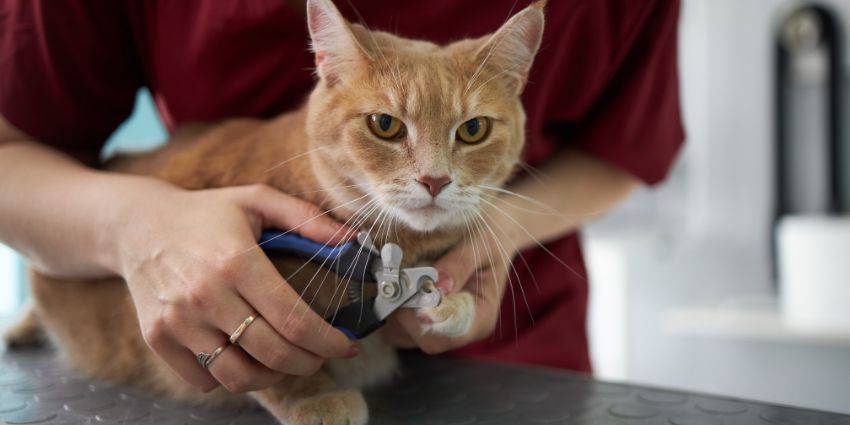If you’ve ever wondered why your feline friend turns your furniture into a scratching post, you’re not alone, but worry not—we’re here to solve it.
In this blog, we’ll explore the world of cat behavior to find out why cats can’t resist scratching our sofas and carpets. Whether they do it out of instinct or for practical reasons, cats use their claws on everything but the designated scratching post.

What does it mean when your cat is scratching
There are a couple of reasons why cats like scratching the furniture and carpets:
1. Territory Marking
Cats are territorial creatures, and scratching is one of their primary methods of marking their territory. Their paw glands release scent markers when they scratch, leaving both an odor and a visible mark that signals ownership to other cats. So, that couch corner isn’t just a cozy spot; it’s their way of saying, “This is mine!”
2. Stretching and Exercise
Scratching is also a full-body workout for our cats. A good scratch stretches the cat’s muscles, especially in the shoulders and back. The session promotes flexibility and muscle health, similar to yoga.
3. Nail Maintenance
Imagine having retractable claws and not using them. Sounds impossible, right? By scratching, cats shed old layers of nails, keeping them sharp and ready for self-defense and climbing.
4. Behavioral and Psychological Factors
Scratching isn’t only instinctual; it can also be a cat’s way of dealing with emotions. Stress, excitement, or anxiety may lead to a scratching spree. It’s like their version of stress relief, helping them cope with the ups and downs of kitty life.
Understanding the reasons behind scratching lets us see it as more than just annoying behavior. So, next time you catch your cat in action, keep in mind that their actions aren’t meant to irritate you; they’re just being their unique, instinct-driven selves.
How can I stop my cat from scratching
If your cat is scratching your furniture, don’t worry – there are ways to redirect their claws. This guide will help you stop unwanted cat scratching without causing drama.
1. Get a Scratching Post
As we mentioned above, it would be a great idea to give your cat a cool scratching post. Cats love to scratch, and a good post can be their favorite spot. Try different scratching posts, such as cardboard, sisal, or carpet, to see what your cat likes. Some cats enjoy horizontal scratching, while others prefer a vertical surface. Finding the right combination ensures your cat will happily redirect their scratching instincts.
2. Try Pheromone Sprays
Pheromone sprays can also help stop your cat from scratching your furniture. These sprays copy scents that tell your cat the spot is already taken.
3. Use Double-Sided Tape
Another way to make furniture and carpets less desirable for scratching is to stick double-sided tape on furniture edges. The stickiness is a little uncomfortable, encouraging them to choose a different spot.
4. Test Cat Nail Caps
Try soft caps for their nails. These soft caps, applied to your cat’s claws, provide a gentle shield, preventing scratches on furniture and surfaces. It’s an easy, painless way to keep both your cat and your belongings happy. Make sure to put them on right though!
5. Add Fun Stuff
Include enjoyable activities! Occasionally, cats scratch when they’re bored. Introduce toys, and climbing structures, and engage in playtime. A happy cat tends to scratch less.
Mix these tips to make a cat-friendly space that saves your furniture. It takes time, so be patient and stick with it.
When to consult a veterinarian
While cats scratching is pretty normal, there are times when it could mean something more. If you’ve tried different things to stop your cat from scratching, like giving them a scratching post, but they’re still at it, it’s time to talk to the vet. They might be scratching because they’re uncomfortable or dealing with a health issue.
Pay attention if your cat looks upset, makes noise, or seems like they’re in pain while scratching. It could mean there’s an issue, like skin irritation, allergies, or maybe even an injury. Also, keep an eye out for changes in how your cat eats or grooms. If they start acting differently or seem tired all the time, it might be a sign of a health problem.
You also need to look at your cat’s skin for any redness, swelling, or sores. If your cat loses hair where they scratch or if their fur doesn’t look right, it means they probably have skin issues or allergies, and a vet can take a close look to find out.
Conclusion
Getting a cat-friendly home starts with understanding your cat’s scratching instincts. Choosing the right scratching post involves trial and error with materials, sizes, and placement. Taking care of their claws with trimming or soft nail caps is a simple act of care.
Be patient—cats need time to get used to changes. Using positive reinforcement, treats, and a bit of creativity ensures a joyful scratching experience.
In the end, it’s about finding a balance where your cat’s natural habits and your furniture peacefully coexist.



